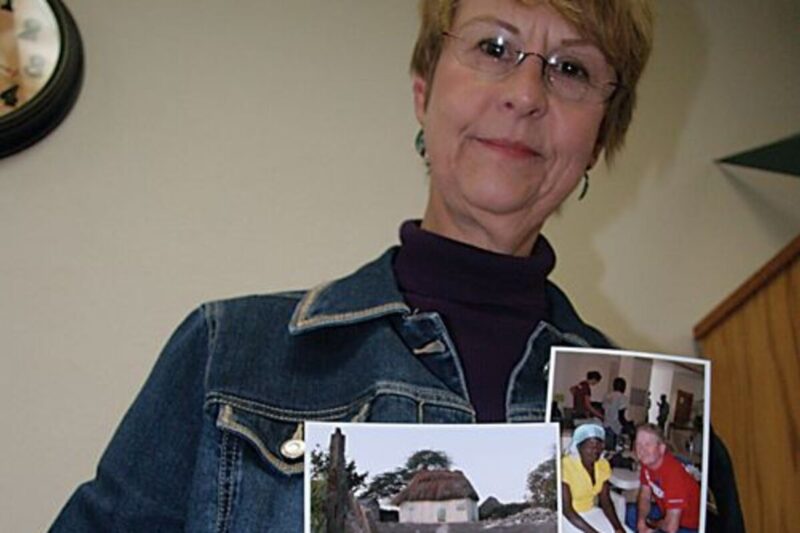Scott Swanson
Rosemary Whitmore, a lifelong Holley resident, had really never been outside of the United States – other than visits to Canada and a “pretty tame” visit to the Mexican border – before she traveled to Haiti last year.
She arrived just days after the 7.0 earthquake that toppled buildings and killed tens of thousands in the Caribbean nation.
“I wasn’t sure until the last minute if I was going to go,” she said, noting that she flew on the first American Airlines commercial flight to Haiti following the earthquake.
It was such a rewarding experience that she went again this year, in February, and has applied to make a third trip next year.
Whitmore, 65, and her husband Richard have attended the First Baptist Church of Brownsville, where she works as church office manager, for years.
Whitmore said she and her husband met Delamy Bazilme, a Haitian pastor who has founded a medical clinic in Terre Blanche, a village about 100 miles north of the capital, Port-au-Prince. Bazilme works with a Washington-based organization called the Haiti Foundation of Hope, which was established in 2005 to coordinate volunteer teams who work at the clinic and support other ministries in the area, which include a school for children, a women’s trade school and a loan program for micro-businesses.
Whitmore said her husband was particularly impressed with Bazilme, whom he considered a “Haitian Renaissance man,” so much so that whenever he spoke in the area, the Whitmores went to hear him.
Then she got interested in visiting Haiti.
“I just felt like I needed to do something,” Whitmore said. “This is something that is totally foreign to me because I like my creature comforts. This is a place where they don’t flush the toilets unless they need to. They don’t use toilet paper.”
Then, after she applied and was accepted to make the trip, Richard died in October 2009, four months before she was supposed to leave. But Whitmore said she sees providence in that.
“I feel like God planned it so I would have something to do with my time,” she said.
It was an experience like none she’d had previously.
“I got thrown into the job of being clinic coordinator the first time I went,” she said.
She didn’t speak French or Creole, the common languages of Haitians, and she was responsible for herding patients into the waiting area and keeping them there until the eight or nine “providers” – mostly volunteer doctors, nurses and emergency medical technicians – could treat them. The clinic now has a Haitian doctor and a nurse who are permanently on the site.
During her last trip the clinic served 1,043 patients in 5½ days.
“I stay on my feet seven hours a day,” Whitmore said. “It’s like herding cats.”
On her last trip, Whitmore traveled with Brownsville farmer Mike Kirk, who is a medic with the local volunteer fire department. She said most of the local volunteers have been from the Brownsville area, though Debbie Waldie, a nurse at Sweet Home Family Medicine, has gone as well.
Conditions – some of them incredibly unsightly – commonly range from infections to growths to congenital problems.
“Mike told me that 50 percent of the patients have malaria,” she said. “Everybody has worms, so everyone who comes into the clinic gets Albendazole.”
The providers ask basic questions and pay close attention to the answers they get through interpreters, she said.
“We’re very dependent on interpreters. If (a patient says) ‘I have fire in my belly,’ it’s H. pylori,” a bacterial infection common in developing countries that causes stomach distress.
Since many patients are uneducated, providers will give them medicine with instructions written in hieroglyphics, such as a sun to indicate “morning” and four lines to indicate four pills.
To avoid getting sick, she takes the anti-malarial drug Chloroquine before, during and for four weeks following her trips. She also uses lots of insect repellent.
This year the country has experienced a cholera epidemic, which, Whitmore said, has helped drive home the clinic’s community health program which has emphasized personal hygiene.
“They began to teach the people last year about washing their hands and they couldn’t be less interested. But then the cholera hit. Because they had had prior training, they knew what they needed to do.”
Though Haiti is the poorest country in the western hemisphere and is incredibly dirty, with little clean running water, she said the people are surprisingly clean and cheerful.
“Every time you go up and down the highway there are clothes hanging out,” she said. “There’s almost no water. I can’t understand how they do it. Haiti is so messy that, at first, you couldn’t tell the earthquake damage from how it usually is.”
But “they do their best to present their very best,” she said. Patients coming into the clinic will sometimes trade clothes outside to make sure they are wearing presentable outfits. Then there’s church.
“They (the women) are dressed in hats and gloves and the little girls have lace anklets on,” Whitmore said. “It blew me away. They sit for hours on benches with no backs. In Haiti, if a bench was meant for five, there’ll be 10 on it. And they sit there and are patient. It amazes me.”
She said she saw a shed on a hillside behind the clinic, a rickety structure with tarps hanging where the walls should be.
“One night, up there, I saw a fire in there,” she said. “I realized people live in it.”
One Haitian friend, a man named Merci Dieu, lives in a mud hut with a dirt floor and a thatched roof – typical in the area. Whitmore said she was “stunned” when she saw the “pantry.”
“The pantry was two corners of the house piled waist high with unground millet,” she said.
Despite their challenges, she said, she’s found Haitians to be warm, friendly people, despite the language barrier.
“They may not feel well, but if you put your arm around them and say ‘bon jour,’ they brighten up and say ‘bon jour.’
“Someone told me the first time I went that I would fall in love with the Haitians. I didn’t realize what they meant because I hadn’t been there. I love them.”
Workers at the clinic were more warm to her this year, she said. “Maybe I proved myself by coming back.”
Dieu and another Haitian man, who are associated with the clinic, call her “Mom.”
“My kids get a kick out of that,” she said. “They say they have two brothers who live in Haiti.”
In addition to the clinic, which has grown from a four-times-a-year to year-round facility, the Haiti Foundation of Hope also operates a school for roughly 1,000 children, who get a meal of beans and rice every day. It also operates a trade school for young women, who, Whitmore said, don’t have much hope in the Haitian culture.
“There’s not much for these girls,” she said. “A lot of them get pregnant because they want to have a baby. It’s very important to have a baby. Unfortunately, they sometimes do it in the wrong order.”
Students who commit to spending a specific amount of time attending the school are taught sewing, how to make patterns and other skills, like how to cater a wedding.
The foundation also sponsors micro-business enterprises run by Haitians. Whitmore said a lot of support for the foundation’s efforts, particularly the clinic, has come from a Haitian woman who was once a truck driver and has become “very wealthy” due to her intelligence and business sense.
“The clinic is a beautiful building,” she said. “They’ve really worked hard to make it not slouchy.”
Whitmore said she wants to make local residents more aware of Haitians’ needs.
“I want people to care,” she said, adding that she is particularly enthusiastic about the Haiti Foundation of Hope, which, she said, is “honest – it’s 100 percent sure (Haitians) will get the money.
“I just feel the need to go do something to help. People would say to me, ‘If Rosemary can go, I can go.’ I felt like God wanted me to.”





